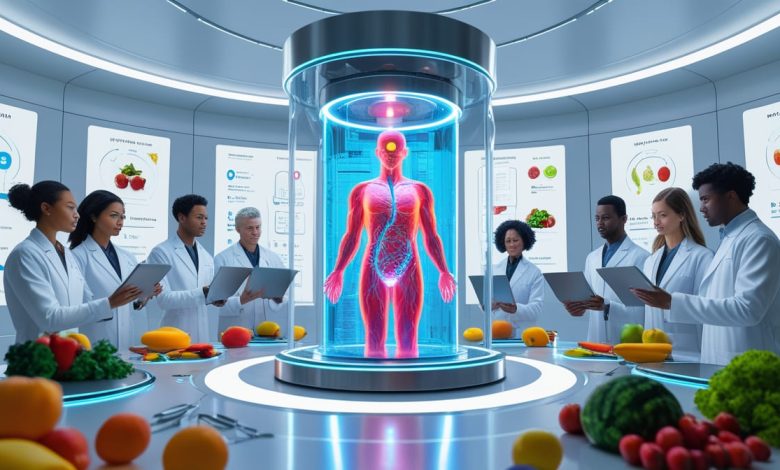
Discover the future of nutrition in 2025 with the latest trends, innovations, and insights. Stay ahead in health and wellness with expert tips on food, supplements, and lifestyle choices.
1. Personalized Nutrition Powered by Data
The days of the one-size-fits-all diets. By 2025, personalized nutrition will be among the biggest trends thanks to technology that will allow us to make better informed and customized choices about the foods we consume according to our own unique biological characteristics.
The personalized nutrition approach will draw upon information from multiple sources – like blood biomarkers, genetic tests and gut microbiome analysis and wearable devices to create food plans customized to each person’s individual needs. Companies such as DNAfit and InsideTracker have already launched diet plans based on DNA that look at how your genes impact the way you process nutrients and react to certain food items.
As time goes by personalizing nutrition will become more readily available, with people having the option of using AI-powered applications that analyze data to recommend specific diets. This will improve everything from weight control and energy levels to preventing chronic diseases.
For more information on the ways technology can help people to manage their diet read our article smart Nutrition How Technology is altering the way we eat.
2. Plant-Based and Alternative Proteins
The food revolution based on plant sources is already underway and, by 2025, we’ll see more creative alternatives to the traditional animal-based protein. With a growing awareness about the environmental consequences of livestock production, a lot of people are switching to vegan diets. In the process, companies such as Beyond Meat and Impossible Foods have seen huge success and are offering alternatives to meat made from plant sources which taste quite like the animal-based alternatives.
In addition to the plant-based protein that are grown in labs, meat from labs is expected to become more readily available by 2025. The lab-grown proteins, which are produced without the requirement to raise and slaughter animals, hold the potential to cut carbon emissions and improve the security of food globally.
If you’re looking for the sustainability of protein, 2025 is expected to bring a new generation of new products, such as insects-based proteins, seaweed and algae. These options are not just green, but they are filled with vital nutrients.
If you’re considering a transition towards a plant-based lifestyle for health and sustainability Explore further in our post on the benefits of eating plants How to Transition to a Sustainable Lifestyle.
For a deeper look at the ways this brand is changing the method we consume protein look up Beyond Meat.
3. Gut Health and the Microbiome Revolution
In recent years, researchers have become more interested in the microbiome of the gut and its effect on general health. In 2025, our knowledge of gut health is expected to improve, and there will be new products and research being developed that focus on the microbiome in order to improve the digestion process, immunity function and even mental well-being.
Probiotic-rich foods such as yogurt, the kimchi and kefir are receiving more attention and are expected to become more common in 2025. In addition, prebiotic food items (foods that encourage the development good gut microbes) such as bananas, garlic and onions are expected to be a major factor in helping to improve the health of the gut.
In the near future the near future, personalized microbiome analyses will soon be similar to blood tests, allowing people to understand the gut bacteria they are consuming and make steps to improve their health.
To better understand the reasons why gut health is crucial and how you can improve it, read the article we wrote regarding the gut’s health Why You Should Care and How You Can improve it.
For more information about how gut health affects digestion and immunity For more information, visit Harvard Health.
4. Functional Foods and Supplements
As we continue to focus on optimizing our health, functional foods and supplements will become an even larger part of the nutrition landscape. Functional foods are those that provide health benefits beyond basic nutrition, and they’ll be increasingly formulated to address specific health concerns.
For example, certain foods will be fortified with ingredients designed to improve brain function, fight inflammation, or support the immune system. Products infused with adaptogens (like ashwagandha, rhodiola, and ginseng) will continue to grow in popularity as consumers seek to manage stress and improve mental clarity.
Supplements will also become more advanced, with the rise of smart supplements that use personalized data to recommend the right combination of vitamins, minerals, and other nutrients for each individual’s needs. This will allow consumers to take a more targeted approach to their health.
For those looking to learn about the most effective supplements for enhancing health, we’ve got you covered in our article on Supplements for Better Health: What Works and What Doesn’t.
To dive deeper into functional foods and their benefits, check out Healthline.
5. Sustainable Eating and the Future of Food Systems
Sustainability will continue to be a driving force in shaping the future of nutrition. In 2025, food systems will evolve to prioritize eco-friendly practices, with an emphasis on reducing waste, conserving resources, and supporting local food production.
Lab-grown meats and plant-based foods will lead the way in reducing the environmental footprint of food production, but there will also be significant advances in regenerative agriculture, vertical farming, and urban food production. These innovations will help feed a growing global population while minimizing the environmental impact.
Food waste will also be addressed through smarter production, packaging, and consumption. Expect to see more businesses and consumers embracing sustainable packaging, reducing food waste, and supporting local farmers and food producers.
Learn how to make sustainable food choices for a better future in our article on Sustainable Eating: Why It’s More Important Than Ever.
For more insights into sustainability practices in the food industry, take a look at World Resources Institute.
6. Technology-Enhanced Meal Planning
As technology continues to advance, so does its role in helping people plan, prepare, and consume healthier meals. In 2025, meal planning will be increasingly powered by apps and AI, with personalized recommendations for nutritious meals based on your health data, preferences, and goals.
Meal delivery services like HelloFresh and Blue Apron will incorporate more personalized options, allowing consumers to choose meals tailored to their dietary needs. Meanwhile, AI-powered nutrition apps like MyFitnessPal and PlateJoy will provide users with meal plans and recipes that align with their specific health goals, whether it’s weight loss, muscle gain, or maintaining a healthy lifestyle.
For tips on how to make meal planning easier and healthier, check out our article on How to Plan Your Meals for Optimal Health.
Discover how a personalized meal planning service like PlateJoy can optimize your nutrition.
In 2025, the future of nutritional science is expected to be a thrilling and transformational one. With the advancements in individualized nutrition, plant-based protein and gut health, as well as sustainable eating, and technologically enhanced food planning, people will have access to greater tools than ever before to improve their health and wellbeing.
As we learn more about the complexity of our health, the nutritional developments of 2025 will not just allow you to eat better, but also more satisfying and sustainable for people and the environment. This is the right time to begin embracing these advancements and take an informed and personalized approach to your food.



